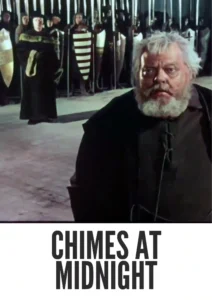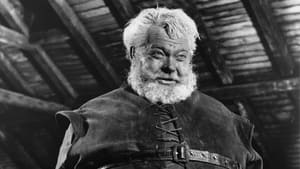Contact: [email protected]
Video Sources 0 Views

Synopsis
Chimes at Midnight 1965: Shakespearean Majesty in Orson Welles’ Masterpiece

Introduction
In the realm of cinematic adaptations of William Shakespeare’s works, “Chimes at Midnight 1965” stands as a towering achievement of storytelling and visual poetry. Directed by the legendary filmmaker Orson Welles, this timeless masterpiece brings to life the iconic character of Sir John Falstaff with breathtaking authenticity and depth. As we embark on a journey through the tumultuous world of medieval England, we uncover the significance of its early colored films version and its enduring legacy as a testament to the genius of one of the greatest playwrights in history.
Check The Full Colorized Movies List
Check Our Colorized Movies Trailer Channel
The Artistry of “Chimes at Midnight”
Welles’ Visionary Direction
At the helm of “Chimes at Midnight” is the visionary American director Orson Welles, whose bold and innovative approach to filmmaking has left an indelible mark on the world of cinema. With its stunning cinematography, evocative set designs, and richly layered performances, the film transports viewers to the heart of medieval England with breathtaking clarity and intensity. Welles’ mastery of the cinematic medium is on full display, as he weaves together a tale of honor, betrayal, and redemption that resonates with timeless relevance and emotional depth.
Compelling Performances
Central to the film’s impact are the compelling performances of its ensemble cast, led by Orson Welles himself in the role of Sir John Falstaff. Welles’ portrayal of the iconic Shakespearean character is a tour de force of emotional depth and complexity, capturing the wit, charm, and vulnerability of a man grappling with his own mortality. Supported by a talented cast of actors, Welles brings depth, nuance, and humanity to his portrayal, imbuing the character of Falstaff with a timeless resonance that transcends cultural boundaries.
Revisiting the Storytelling Mastery: Plot and Themes
A Shakespearean Epic
“Chimes at Midnight” unfolds as a Shakespearean epic, weaving together elements from several of the Bard’s most iconic plays, including “Henry IV,” “Henry V,” “Richard II,” and “The Merry Wives of Windsor.” Through its richly textured storytelling and profound thematic depth, the film explores the timeless themes of honor, loyalty, and the nature of power. As Sir John Falstaff navigates the treacherous world of medieval politics and warfare, he grapples with the complexities of friendship, betrayal, and redemption, offering viewers a glimpse into the human condition with unparalleled insight and empathy.
Themes of Honor and Betrayal
At the heart of “Chimes at Midnight” are its themes of honor and betrayal, which resonate throughout the film with profound emotional resonance. As Falstaff and his companions navigate the treacherous waters of courtly intrigue and battlefield warfare, they confront the moral dilemmas and ethical ambiguities inherent in their quest for power and prestige. Through their struggles and sacrifices, Welles invites viewers to contemplate the nature of honor, loyalty, and the price of ambition in a world defined by deception and duplicity.
The Dynamic Relationship Between Friendship and Duty
The Bonds of Brotherhood
“Chimes at Midnight” serves as a meditation on the bonds of brotherhood and the complexities of friendship in the face of adversity. As Falstaff and Prince Hal navigate the turbulent waters of medieval England, they forge a deep and enduring bond that transcends the constraints of class and convention. Through their shared experiences and mutual respect, they discover the true meaning of loyalty and sacrifice, standing together against the forces of tyranny and oppression with courage and conviction.
The Burden of Leadership
Against the backdrop of political intrigue and military conflict, “Chimes at Midnight” explores the burden of leadership and the responsibilities that come with wielding power. As Prince Hal ascends to the throne and assumes the mantle of kingship, he is forced to confront the challenges of governance and the weight of his own conscience. Through his journey from prodigal son to noble monarch, Welles highlights the transformative power of leadership and the enduring legacy of honor and integrity in the face of adversity.
A Visual and Technical Achievement
Cinematic Grandeur
Shot in luminous black-and-white, “Chimes at Midnight” is a visual tour de force that captures the beauty and brutality of medieval England with breathtaking clarity and precision. From its sprawling battle scenes to its intimate character moments, every frame is a work of art, meticulously composed and imbued with symbolic meaning. Welles’ use of light, shadow, and composition creates a mesmerizing and immersive experience that transports viewers to the heart of the action, inviting them to bear witness to the triumphs and tragedies of a bygone era.
Early Colored Films Version
In a departure from convention, the filmmakers behind “Chimes at Midnight” experimented with an early colored films version of the movie, offering audiences a new perspective on its timeless tale. This innovative approach to colorization adds depth and nuance to the film’s visuals, enriching its already mesmerizing aesthetic and enhancing the overall viewing experience.
Behind the Scenes of “Chimes at Midnight”
Welles’ Artistic Process
Behind the camera, Orson Welles and his team worked tirelessly to bring “Chimes at Midnight” to life with authenticity and integrity. From the elaborate set designs to the evocative cinematography and haunting score, every aspect of the production was crafted with meticulous care and attention to detail. Welles’ uncompromising commitment to his artistic vision shines through in every frame, as he pushes the boundaries of cinematic expression to create a work of unparalleled beauty and emotional resonance.
Collaborative Creativity
One of the most remarkable aspects of “Chimes at Midnight” is the collaborative spirit that infused every aspect of its creation. From the dedicated performances of the cast to the innovative contributions of the production crew, each member of the team played a vital role in bringing Welles’ vision to life. Through their collective efforts, they created a cinematic masterpiece that continues to inspire and captivate audiences around the world.
Legacy and Influence on Cinema
Critical Acclaim and Cultural Impact
Upon its release, “Chimes at Midnight” received widespread critical acclaim, with particular praise for its stunning visuals, powerful performances, and profound thematic depth. Over the years, the film has attained legendary status among cinephiles and scholars alike, inspiring countless filmmakers to explore the complexities of Shakespearean drama with honesty and authenticity.
Inspiring Future Generations
“Chimes at Midnight” has left an indelible mark on the world of cinema, inspiring filmmakers and audiences alike to contemplate the timeless themes of honor, loyalty, and the human condition. Its enduring legacy serves as a testament to the enduring power of Shakespeare’s works to resonate across time and culture, inviting viewers to engage with the beauty and complexity of the human experience with courage, compassion, and understanding.
Where to Watch “Chimes at Midnight 1965 Full Movie”?
For those eager to experience the epic grandeur of “Chimes at Midnight” in its entirety, the film is readily available on various streaming platforms and home video releases. Whether you’re a seasoned Shakespeare enthusiast or a newcomer to the world of Elizabethan drama, “Chimes at Midnight” promises a journey unlike any other—a journey into the heart of honor, betrayal, and redemption.
In Conclusion
“Chimes at Midnight 1965” stands as a timeless testament to the power of Shakespeare’s works to transcend time and culture, resonating with audiences around the world with its timeless themes and universal truths. With its stunning visuals, powerful performances, and profound thematic depth, the film continues to captivate and inspire, inviting viewers to contemplate the nature of honor, loyalty, and the human condition with courage, compassion, and understanding. As we revisit this cinematic masterpiece, let us embrace its invitation to engage with the beauty and complexity of Shakespearean drama, celebrating the enduring legacy of one of the greatest playwrights in history.



















